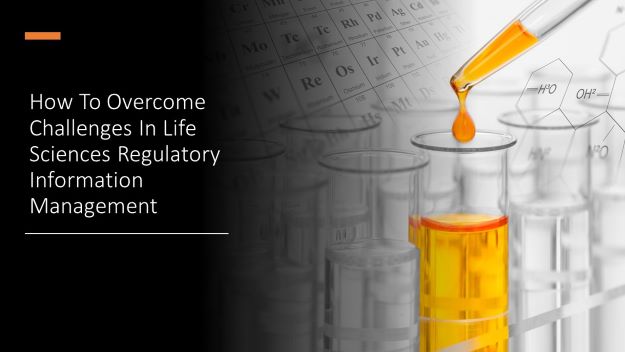Business process automation
The Life Sciences industry is highly regulated, requiring companies to maintain a high level of compliance and information management.
Regulatory information management systems help organizations stay current on regulations, plan for compliance and execute on compliance strategies. Historically, this information has been housed in a variety of systems, including Excel documents and pen-and-paper repositories. This has created numerous challenges and costs that can impact time to market and patient outcomes.
Many organizations have recognized that business process automation can help them improve their overall process efficiency. Many have already started implementing automation in pilot projects, and the results have been promising. However, many companies are still struggling to apply new approaches at scale. In addition, some technologies are still in their infancy, so organizations are unsure of how to apply them properly.
Automation is a multifaceted endeavor, and its application can strain even the most experienced leaders. In many cases, the process can be redesigned to take advantage of existing execution maturity and familiar ways of working. For example, piloting new technologies early can help increase awareness and quickly demonstrate value. Shrewd leaders will consider how fast a company can implement automation and focus their efforts on more advanced technologies while still addressing basic needs.
Unstructured data
Unstructured data is a valuable resource in the life sciences, but its handling poses a number of challenges. A well-designed diagnosis tool incorporates both structured and unstructured data, which can be used to extract useful information and produce better outcomes. However, the availability of clinical data is restricted by ethical and data sensitivity issues, and data quality is an important challenge. Improved methods are needed to improve data quality. There are also open challenges to the generalization of machine learning algorithms and the explanation of their findings.
As a result, organizations must develop automated processes to handle unstructured data. For example, IQVIA's cloud-based Regulatory Intelligence platform can address the unstructured data challenges, while delivering organized regulatory data from different sources and across different countries. The data connection process can improve the chain of evidence and enhance confidence in sponsor submissions.
For life sciences organizations, the introduction of a new data management ecosystem can improve regulatory information management and speed up drug development processes. By automating data collection and authoring processes, pharmaceutical companies can streamline their regulatory information management workflows.
Disparate sources of data
Data management is a major challenge for life sciences organizations. Today, regulatory submissions can consist of thousands of pages of data, relying heavily on narratives written by subject matter experts. However, these narratives are subject to subjectivity. The issue of data quality is compounded by the fact that different reviewers and authors have different interpretations of the same data.
To effectively manage this data, a system must be capable of handling diverse sources of information. This includes disparate types of data and unstructured data. Data sources should be interoperable and have the ability to be translated to a common format. The data must also be processed properly to account for differences in data formats and accuracy. In addition, data analysis must take into account differences across health systems and claims. In addition, artificial intelligence capabilities are often needed to make sense of complex data.
Regulatory information management requires a holistic approach to data management. Historically, product information and regulatory intelligence has existed in silos across the industry. This makes it difficult to have an accurate picture at any time. However, big data analytics allows organizations to integrate data from a variety of sources and create meaningful insights.
Slow submission process
As the cost of pharmaceuticals continues to rise, life sciences companies are seeking new methods to improve speed and efficiency in their regulatory information management.
One approach is to change the traditional serial publishing process to a continuous one. With continuous publishing, regulatory teams are able to identify issues and resolve validation errors in real time. This eliminates the need for manual handoffs and streamlines the process from planning to submission.
While life sciences organizations recognize that they must catch up to competitors in other industries, the regulatory burden often slows them down. Even though the red tape is necessary for patient’s safety, it can also limit agility, responsiveness, and innovation. With the right system, life sciences companies can save both time and money.
Applying Lean and Kaizen principles for modernizing RIM will reduce the project cost and also speed-up the transition.
Related Reading:
- Operational Excellence FAQ: Why should you modernize regulatory information management in life sciences organizations?
- Challenges in Modernizing Life Sciences Regulatory Information Management Systems
- USFDA Guidance on Life Sciences Regulatory Information Management
- Economic Impact of Life Sciences Regulatory Information Management
- What are the drawbacks if Regulatory Information Management (RIM) of life sciences organizations is not modernized?
- Modernize regulatory information management to improve operational excellence in life science organizations
- Benefits of modernizing life sciences Regulatory Information Management
- Transitioning from Computer Software Validation (CSV) to Computer Software Assurance (CSA)
Categories: Life Sciences | Operational Excellence
Keywords and Tags:
#RegulatoryInformationManagement #RIM #lifesciences #continuousimprovement #operationalexcellence #continuousimprovementforlifescienceindustry #changemanagement #kaizenforpharmaceuticals





















